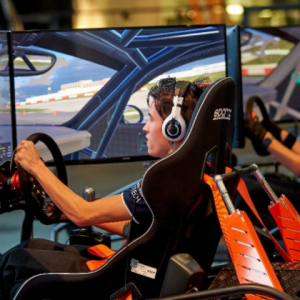FIFA – an introduction
FIFA is a football simulation video game published by Electronic Arts as part of the FIFA-series. A total of 28 […]

FIFA is a football simulation video game published by Electronic Arts as part of the FIFA-series. A total of 28 […]

Racing cars are very complex machines. Apart from the fact that every car behaves differently, two equal cars may behave differently as well, depending on their settings. The collection of settings is known as a car setup, a term widely used in real-life motorsports, but also in simracing. In this blog is discussed what car setups are exactly, and how they can make you go faster around the (virtual) track.

Simracing as an esport was already well on its way to becoming mainstream, but just like a lot of other online activities, simracing got a massive boost in growth due to the global pandemic. With real-life Formula 1 drivers like Max Verstappen, Lando Norris and Charles Leclerc joining in to compete, viewership on Twitch (and sometimes even national television) have reached new all-time highs.

Starting in early March 2021 ETT will host a showcase-event in collaboration with the EsportsLab and the BMS lab. During this event all the new developments in the fields of Esports research will be demonstrated. Hopefully, this will be a recurring event where on a (semi-)yearly basis the UT hosts an Esports research showcase where thousands of students can experience our recent projects.

With the first official four months behind us, the ETT members can look back on a successful start of the newest UT student team. Though not all set objectives are achieved in the past few months, we can be happy with the progress we made so far. In this short two-part blog, I will review what ETT and her members have been doing so far. Especially in the second part of this blog I will also discuss what our specific plans and goals are for the upcoming five years! So, stay tuned and have fun reading!

Our data analysis team aims to support our athletes by providing them with information and tools they can easily and effectively use to improve their performance. The team has been working on Rocket League next to League of Legends the past couple of months. For Rocket League, we are working on basic positioning and boost usage statistics. These are statistics that are not provided to players in-game, but are two of the most important skills a good Rocket League athlete has to master. All these statistics and tools are packaged into a dashboard, that aims to help coaches and players to analyse games more efficiently and effectively. In this article we explore what very simple positioning information (heatmaps) can already tell us about the course of a match in Rocket League.

My name is Bob “Supp Ins” Gellaerts currently working as one of the three coaches for the Esports Team Twente (ETT) League of Legends team.
League of Legends is a MOBA (multiplayer online battle arena) game where two teams of five players need to destroy the base of the opponent through strategy and character skills. As a coach I review and prepare my team for upcoming games in the Dutch College League. We make sure that our players are well prepared to play their matches in a landscape that is always changing. Due to several updates the rules of the games continuously change.

If you have played League of Legends you probably have heard of sites like op.gg or mobalytics. Those sites give you all kinds of information on yourself but also on other summoners. All that information comes right from the Riot API (a kind of database where we can pull information from). At ETT we are working on our own version.